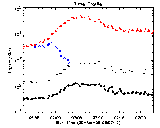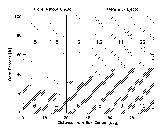Flare Eruptivity as Observed by SXT
Science Nugget: Apr 02, 1999
There was a long-awaited M-class flare on 2-Apr-99.
Around this flare, which came from the east limb, SXT images showed an
eruptive event on the northwest limb. Both AR 8498 and AR 8497 (closer
to the limb) brightened. Click the following image for a movie of the eruption.

Note that AR 8497 assumed a nice ``sigmoid'' appearance a couple of
days before.
1. X-ray Ejection in Solar Flares
This week's nugget gives a preliminary study of how often X-ray ejection
is observed in association of flares.
In last week's nugget, we mentioned
potential difficulty of identifying signatures of a coronal mass ejection
(CME) in SXT images. It has been known for long that a CME can occur away
from active regions marked by sunspots, but some CMEs are clearly associated
with flares, phenomena seen only in active regions. A large number of CME-associated
flares are long duration events (LDEs) that characteristically involve
cusp geometry. Irrespective of the presence of cusp, SXT time sequence
images of flares occasionally show ejecta, which might or might not represent
a lower part of a CME, even from relatively short duration events. See
Shibata
et al. (1995) in ApJ Letters, who wrote emphatically that all these
(eight) flares were associated with X-ray plasma ejections high above the
soft X-ray loop. On the other hand, we empirically know that some flares
do not show any ejection at all in SXT images. Similarly, it is well known
that the correlation between flares and CMEs is quite poor, implying that
only certain types of flares have CME connections. Therefore we would like
to find out if the presence of X-ray ejection has anything to do with the
relation between flares and CMEs. But before reaching any meaningful conclusions,
we need to make sure that some flares indeed lack X-ray ejection, since
various observing conditions could prevent the ejection from being detectable.
Click the following image for a movie showing X-ray ejection in a small
flare at N03W67 (20-Apr-96, 07 UT) which was observed in non-flare (quiet)
sequence. The cadence is 50-60 seconds.

Note that the primary ejection is fast and directed toward southwest,
but that loops north of the central flare also appear to rise slowly.
2. Factors that may Affect the Eruptive Look
Not all the Yohkoh flares show as spectacular an ejection as the
flare presented above. It is likely that some flares are intrinsically
confined and non-eruptive. But suppose all the flares are equally eruptive.
Then, given that X-ray ejection is much fainter than the flare, the following
factors may affect the detectability of the ejection. Some are related
with others.
Data coverage. The first SXT image of a flare is often taken only after
the impulsive phase, by which time the ejection may have been over. In
other cases, observations may be terminated because of, e.g., satellite
night, before significant ejections take place.
Strong background emission due to the flare (scatterd light) and/or adjacent
non-flaring loops.
Limited dynamic range of the (CCD) detector. If the automatic exposure
control (AEC) is on, exposures become shorter as the flare becomes brighter,
making it difficult to see faint features.
Dark and straylight subtractions. One has to use right database and appropriate
correction scheme, to retrieve weak signals.
Sampling rate of the images. A fast ejection could happen between two successive
images, depending on the apparent speed of the ejection and the cadence.
Limited field-of-view. It appears that different ejections are most easily
seen in images of different fields-of-view. Sometimes the available fields-of-view
are either too small or too large.
Direction of the ejection projected on to the image plane. As an extreme
case, if the ejection is collimated and parallel to the line of sight,
we will not see it.
3. Analysis
We select 140 flares that occurred in 1996, i.e., around solar minimum
when quiescent emission was generally weak. The selection is based on the
criterion that SXT started observing the flare well before the GOES peak.
This is because we are looking for ejections that are probably connected
to the primary energy release rather than secondary effects. X-ray ejections
are visually identified in time-sequence images played as movie and in
difference images. We count only those ejections that run at least twice
the extent of the flare. As a result, we pick up only obvious ejections,
throwing away marginal ones. We find X-ray ejections in 57 flares.
Although this is still preliminary, we try to estimate the background
level that affects the detectability of the ejection. We calculate the
model background of a given image from interpolating only non-flare pixels.
We determine the background at the position of the ejection using the fluctuation
in the model. In the following plot, we show light curves for the flare
(red), the ejection (blue), the average background (square), and 3 x the
fluctuation (line). It is clear that the main contributor to the background
is the flare itself, when the projected location of the ejection is not
far away from it.

The following plot shows how the flares with and without X-ray ejections
are distibuted in solar longitude. Even though there is no clear correlation
of the background level with the longitude, more events with X-ray ejections
are actually close to the limb. This may imply that an ejection coincides
with the direction of the line of sight in disk events.

4. Summary
In this work, we find X-ray ejections in 40 % of the 140 events studied.
All of them are observed before the GOES peak, i.e., during the impulsive
phase. We cannot completely rule out the possibility that all the events
are in fact eruptive, with weak X-ray ejections undermined in the background.
It is interesting to hear (Ohyama, 1999, private communication) that ejection
from the current sheet responsible for the primary energy release may manifest
in a modest way, and that spectacular ejections such as those we study
may correspond to secondary reconnection of the ejected plasmoid with overlying
magnetic field. This seems to be still in a speculation stage, however.
4 April 1999: Sachiko Akiyama (akiyama@flare2.solar.isas.ac.jp), Nariaki
Nitta (nitta@lmsal.com)



